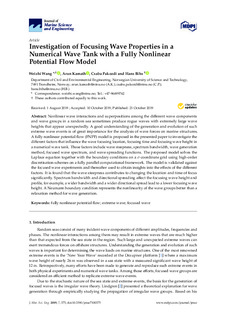| dc.contributor.author | Wang, Weizhi | |
| dc.contributor.author | Kamath, Arun | |
| dc.contributor.author | Pakozdi, Csaba | |
| dc.contributor.author | Bihs, Hans | |
| dc.date.accessioned | 2020-02-18T10:37:55Z | |
| dc.date.available | 2020-02-18T10:37:55Z | |
| dc.date.created | 2019-10-21T15:46:38Z | |
| dc.date.issued | 2019 | |
| dc.identifier.citation | Journal of Marine Science and Engineering. 2019, 7 (10), . | nb_NO |
| dc.identifier.issn | 2077-1312 | |
| dc.identifier.uri | http://hdl.handle.net/11250/2642230 | |
| dc.description.abstract | Nonlinear wave interactions and superpositions among the different wave components and wave groups in a random sea sometimes produce rogue waves with extremely large wave heights that appear unexpectedly. A good understanding of the generation and evolution of such extreme wave events is of great importance for the analysis of wave forces on marine structures. A fully nonlinear potential flow (FNPF) model is proposed in the presented paper to investigate the different factors that influence the wave focusing location, focusing time and focusing wave height in a numerical wave tank. Those factors include wave steepness, spectrum bandwidth, wave generation method, focused wave spectrum, and wave spreading functions. The proposed model solves the Laplace equation together with the boundary conditions on a σ -coordinate grid using high-order discretisation schemes on a fully parallel computational framework. The model is validated against the focused wave experiments and thereafter used to obtain insights into the effects of the different factors. It is found that the wave steepness contributes to changing the location and time of focus significantly. Spectrum bandwidth and directional spreading affect the focusing wave height and profile, for example, a wider bandwidth and a wider directional spread lead to a lower focusing wave height. A Neumann boundary condition represents the nonlinearity of the wave groups better than a relaxation method for wave generation. | nb_NO |
| dc.language.iso | eng | nb_NO |
| dc.publisher | MDPI | nb_NO |
| dc.rights | Navngivelse 4.0 Internasjonal | * |
| dc.rights.uri | http://creativecommons.org/licenses/by/4.0/deed.no | * |
| dc.title | Investigation of Focusing Wave Properties in a Numerical Wave Tank with a Fully Nonlinear Potential Flow Model | nb_NO |
| dc.type | Journal article | nb_NO |
| dc.type | Peer reviewed | nb_NO |
| dc.description.version | publishedVersion | nb_NO |
| dc.source.pagenumber | 28 | nb_NO |
| dc.source.volume | 7 | nb_NO |
| dc.source.journal | Journal of Marine Science and Engineering | nb_NO |
| dc.source.issue | 10 | nb_NO |
| dc.identifier.doi | 10.3390/jmse7100375 | |
| dc.identifier.cristin | 1739202 | |
| dc.description.localcode | © 2019 by the authors. Licensee MDPI, Basel, Switzerland. This article is an open access article distributed under the terms and conditions of the Creative Commons Attribution (CC BY) license (http://creativecommons.org/licenses/by/4.0/). | nb_NO |
| cristin.unitcode | 194,64,91,0 | |
| cristin.unitname | Institutt for bygg- og miljøteknikk | |
| cristin.ispublished | true | |
| cristin.fulltext | original | |
| cristin.qualitycode | 1 | |

